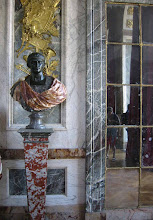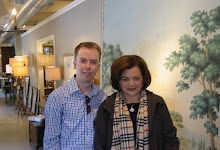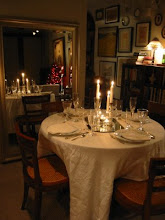
Some of you may remember last year when I wrote a brief post on
the Red House, the (brief) home of William Morris designed in partnership with Philip Webb in 1859.

While flipping through the book "Small country houses of to-day" by Lawrence Weaver circa 1910, I came across a critique of the house with photos and plans from that time period.

The house had not yet achieved the cult status it enjoys today and the critique is fair and unbiased. Rather than emphasizing the artistic merits of the design Weaver looks at it from the useage of a family home; A fair analysis as this is what it was designed as (not the museum it is today).

While certainly overall a positive look at the house, he points out fatal flaws such as a west-facing kitchen which becomes overheated while preparing dinner. Also that the primary rooms face east and north and remain dark and dreary throughout the day. Certainly not what Morris or Webb intended!

Siting of a house is certainly the most important aspect of design and is so often forgotten in favor of siting the house practically with no regard as to how it is to be used. For example, bedrooms should face east to receive the morning light (or the opposite if so prefered) with living rooms facing south to enjoy the most natural light.

Rooms such as kitchens and baths which are used all day long naturally belong on the northern exposure where natural light is received throughout the day in equal doses. That leads to the problem of ventilation which so often is currently relegated to mechanical systems which never work 1/2 as well as natural ventilation (windows).

Also included in the article are many photographs of original furniture, Morris-designed, which were left when the house was sold.

The 'settle' above shows a number of large leather bound books -don't you wonder what those are? Weaver also raises the question why the minstrel gallery was built above the bench but I think it is so charming that it negates further questioning!

Always such a pleasure to see a house
before and
after where the house is so well maintained. I hope you enjoy the
Red House as well!
 Some of you may remember last year when I wrote a brief post on the Red House, the (brief) home of William Morris designed in partnership with Philip Webb in 1859.
Some of you may remember last year when I wrote a brief post on the Red House, the (brief) home of William Morris designed in partnership with Philip Webb in 1859. While flipping through the book "Small country houses of to-day" by Lawrence Weaver circa 1910, I came across a critique of the house with photos and plans from that time period.
While flipping through the book "Small country houses of to-day" by Lawrence Weaver circa 1910, I came across a critique of the house with photos and plans from that time period. The house had not yet achieved the cult status it enjoys today and the critique is fair and unbiased. Rather than emphasizing the artistic merits of the design Weaver looks at it from the useage of a family home; A fair analysis as this is what it was designed as (not the museum it is today).
The house had not yet achieved the cult status it enjoys today and the critique is fair and unbiased. Rather than emphasizing the artistic merits of the design Weaver looks at it from the useage of a family home; A fair analysis as this is what it was designed as (not the museum it is today).  While certainly overall a positive look at the house, he points out fatal flaws such as a west-facing kitchen which becomes overheated while preparing dinner. Also that the primary rooms face east and north and remain dark and dreary throughout the day. Certainly not what Morris or Webb intended!
While certainly overall a positive look at the house, he points out fatal flaws such as a west-facing kitchen which becomes overheated while preparing dinner. Also that the primary rooms face east and north and remain dark and dreary throughout the day. Certainly not what Morris or Webb intended! Siting of a house is certainly the most important aspect of design and is so often forgotten in favor of siting the house practically with no regard as to how it is to be used. For example, bedrooms should face east to receive the morning light (or the opposite if so prefered) with living rooms facing south to enjoy the most natural light.
Siting of a house is certainly the most important aspect of design and is so often forgotten in favor of siting the house practically with no regard as to how it is to be used. For example, bedrooms should face east to receive the morning light (or the opposite if so prefered) with living rooms facing south to enjoy the most natural light.  Rooms such as kitchens and baths which are used all day long naturally belong on the northern exposure where natural light is received throughout the day in equal doses. That leads to the problem of ventilation which so often is currently relegated to mechanical systems which never work 1/2 as well as natural ventilation (windows).
Rooms such as kitchens and baths which are used all day long naturally belong on the northern exposure where natural light is received throughout the day in equal doses. That leads to the problem of ventilation which so often is currently relegated to mechanical systems which never work 1/2 as well as natural ventilation (windows). Also included in the article are many photographs of original furniture, Morris-designed, which were left when the house was sold.
Also included in the article are many photographs of original furniture, Morris-designed, which were left when the house was sold.  The 'settle' above shows a number of large leather bound books -don't you wonder what those are? Weaver also raises the question why the minstrel gallery was built above the bench but I think it is so charming that it negates further questioning!
The 'settle' above shows a number of large leather bound books -don't you wonder what those are? Weaver also raises the question why the minstrel gallery was built above the bench but I think it is so charming that it negates further questioning! Always such a pleasure to see a house before and after where the house is so well maintained. I hope you enjoy the Red House as well!
Always such a pleasure to see a house before and after where the house is so well maintained. I hope you enjoy the Red House as well!









































.JPG)








































































5 comments:
A nice reminder that the quality of architecture is not found in facades and surface appearances so much as in floor plans and livability. Although for a client such as William Morris, ornament and attractive rooms do take on an increased importance.
Stefan, have you ever heard how people of a couple hundred years ago would often site their house according to where their cattle would choose to rest? I read that a while back and found it most interesting — I wish now that I could quote the source.
Parnassus -it's all part of a whole!
Mark - cattle?! Towards or away from? Thats so fascinating!
Great post! I love contemporary reviews because they have photographs of original architecture and furniture that Morris-designed, before it was changed by later owners. But also, as you noted, the contemporary analysis was more balanced, given that the house had not yet reached god-like status.
Wow, what a beautiful designs and how perfectly designs these rooms and the idea for designing is brilliant .
Post a Comment